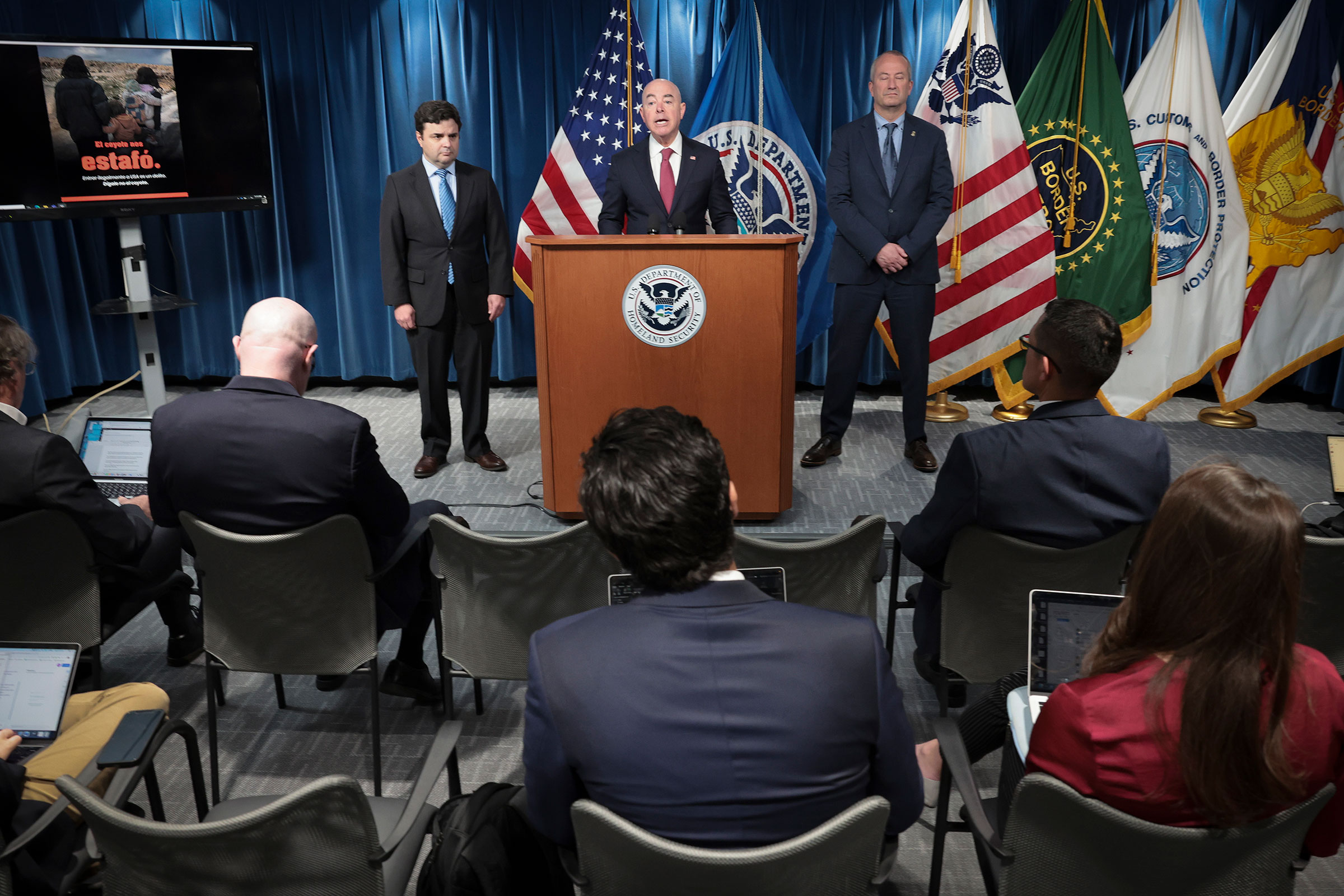Anticipating a border surge when Title 42 lifts on Thursday, the Biden Administration announced several enforcement and diplomatic measures aimed at stemming the flow of migrants unlawfully crossing the U.S.-Mexico border.
Department of Homeland Security (DHS) Secretary Alejandro Mayorkas said Wednesday that the Administration is bracing for increases in unauthorized border crossings, which are already at record levels, once the pandemic restrictions end on May 11 at 11:59 p.m. ET. The Trump-era authorities prevented migrants from requesting asylum and allowed U.S. border agents to quickly expel migrants for public-health reasons.
With the end of Title 42 looming, Mayorkas described the vexing and potentially destabilizing challenges the nation faces in the mounting crisis. Crowds of migrants have gathered in Mexico in recent days as border cities—and places as far afield as Chicago and New York—have declared states of emergency in response to the thousands of migrants arriving without food and shelter. “This places an incredible strain on our personnel, our facilities and our communities with whom we partner closely,” Mayorkas told reporters at DHS headquarters. “Our plan will deliver results, but it will take time for those results to be fully realized.”
The Administration’s plan hinges on boosting the federal law-enforcement presence along the border, reinforcing penalties for those who cross illegally, and enhancing collaboration with international partners. Mayorkas acknowledged these are short-term fixes that will not deliver lasting results and called upon Congress to deliver new legislation. “Our immigration laws today are outdated,” he said. “The solutions we are implementing are the best available within our current legal authority. But they are short-term solutions to a decades-old problem.”
DHS is adding more than 24,000 law-enforcement personnel and 1,100 new Customs and Border Patrol (CBP) processing coordinators, which is double the number from last year. About 1,500 active-duty troops have been called to the border to assist CBP in an administrative capacity. The first 550 service members arrived Tuesday near El Paso, Texas, to perform support duties like data entry and warehouse work that’s intended to free up CBP agents to detain and process migrants.
Read More: Why the U.S. May Be Days Away From a Border Crisis
DHS will deploy up to 1,000 officers to interview asylum-seekers, along with “thousands” of contract personnel, according to senior Administration officials who spoke to reporters Tuesday on the condition of anonymity. “This is a really unprecedented moment in the Americas,” one official said. “Twenty million people are displaced across the region. The COVID-19 pandemic, political insecurity, and climate change have exacerbated what was normally pushing people to migrate.”

The Administration also has new and controversial policy measures that will largely deny asylum to migrants crossing the U.S.-Mexico border illegally after passing through a third country. Proposed earlier this year, the measure presumes migrants are ineligible for U.S. asylum if they didn’t seek sanctuary in a country they traveled through, such as Mexico, on the way to America’s southwest border. If they are ineligible for asylum, they could be deported through a process dubbed “expedited removal,” which would bar them from the U.S. for five years. For the first time, the Administration also plans to return Cubans, Nicaraguans, Haitians, and Venezuelans to Mexico if they illegally cross the border.
More than 27,000 migrants are currently in CBP custody, the Administration said, so the agency plans to open two new holding facilities while the Department of Health and Human Services, which houses unaccompanied migrant children, builds out its capacity. Immigration and Customs Enforcement (ICE) intends to accelerate deportation flights.
More than 665,000 people have been removed during the first six months of the current fiscal year, Mayorkas said. “We are making it very clear that our border is not open, that crossing irregularly is against the law, and that those who are not eligible for relief will be quickly returned,” he said. The Administration is depending on partner countries to help, building on the Los Angeles Declaration’s promise to “work together to address the migration crisis in a comprehensive manner.” The document was signed last summer by the U.S. and more than 20 other partners.
Read More: What Life Is Like for Troops At the Border Who Are Waiting With No Enemy to Fight.
One necessary ally is Mexico, which shares a 2,000-mile border with the U.S. President Biden spoke Tuesday with Mexican President Andrés Manuel López Obrador about the mounting crisis, and senior officials said they expect Mexico to soon increase its immigration enforcement. The Administration says it intends to open regional processing centers in locations throughout Central America where migrants apply for a legal pathway of entry, but the timeline remains unclear. It also plans to launch a CBP app which will allows non-citizens to schedule appointments to present themselves at southwest border ports.
When asked by reporters Tuesday about the end of Title 42, Biden said it “remains to be seen” how the strategy will play out. “We are doing all we can,” Biden said, later adding: “It’s going to be chaotic for a while.”
More Must-Reads from TIME
- Cybersecurity Experts Are Sounding the Alarm on DOGE
- Meet the 2025 Women of the Year
- The Harsh Truth About Disability Inclusion
- Why Do More Young Adults Have Cancer?
- Colman Domingo Leads With Radical Love
- How to Get Better at Doing Things Alone
- Michelle Zauner Stares Down the Darkness
Write to W.J. Hennigan at william.hennigan@time.com